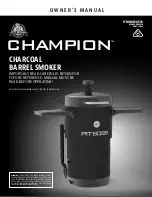
Cleaning
en
27
Notes
■
Slight differences in colour on the front of the
appliance are caused by the use of different
materials, such as glass, plastic and metal.
■
Shadows on the door panels, which look like
streaks, are caused by reflections made by the
interior lighting.
■
Enamel is baked on at very high temperatures.This
can cause some slight colour variation. This is
normal and does not affect operation.
The edges of thin trays cannot be completely
enamelled. As a result, these edges can be rough.
This does not impair the anti-corrosion protection.
Surfaces in the cooking compartment
The back wall, ceiling and side parts in the cooking
compartment are self-cleaning. You can tell this from
the rough surface.
The cooking compartment floor is enamelled and has
smooth surfaces.
Cleaning enamel surfaces
Clean the smooth enamel surfaces with a dish cloth
and hot soapy water or a vinegar solution. Then dry
them with a soft cloth.
Soften baked-on food remnants with a damp cloth and
soapy water. Use stainless steel wire wool or oven
cleaner to remove stubborn dirt.
Caution!
Never use oven cleaner in the cooking compartment
when it is still warm. This may damage the enamel.
Remove all food remnants from the cooking
compartment and the appliance door before you next
heat up the appliance.
Leave the cooking compartment open to dry after
cleaning it.
Note:
Food residues can cause white deposits to form.
These are harmless and do not affect how the
appliance works. You can remove these residues using
lemon juice if required.
Cleaning self-cleaning surfaces
The self-cleaning surfaces are coated with a porous,
matte ceramic layer. This coating absorbs and dispels
splashes from baking and roasting while the appliance
is in operation.
If the self-cleaning surfaces no longer clean themselves
sufficiently and dark stains appear, they can be cleaned
using the cleaning function. To do this, refer to the
information in the relevant section.
Caution!
Do not use oven cleaner on self-cleaning surfaces. This
will damage the surfaces. If oven cleaner does get onto
these surfaces, dab it off immediately using water and a
sponge cloth. Do not rub the surface and do not use
abrasive cleaning aids.
Keeping the appliance clean
Always keep the appliance clean and remove dirt
immediately so that stubborn deposits of dirt do not
build up.
:
Warning – Risk of fire!
Loose food remnants, fat and meat juices may catch
fire. Before using the appliance, remove the worst of the
food remnants from the cooking compartment, heating
elements and accessories.
Tips
■
Clean the cooking compartment after each use. This
will ensure that dirt cannot be baked on.
■
Always remove flecks of limescale, grease, starch
and albumin (e.g. egg white) immediately.
■
Use the universal pan for baking very moist cakes.
■
Use suitable ovenware for roasting, e.g. a roasting
dish.
Accessories
Hot soapy water:
Soak and then clean with a dish cloth or a
brush.
Enamelled accessories are dishwasher-suita-
ble.
Aluminium baking tray*:
(depending on appliance model)
Dry with a soft cloth.
Do not clean in the dishwasher.
Never use oven cleaner.
To prevent scratches, never touch the metal
surfaces with a knife or a similar sharp object.
Harsh cleaning products, scratchy sponges
and rough cleaning cloths are not suitable.
Otherwise, you may scratch the surface.
Rotary spit*
(depending on appliance model)
Hot soapy water:
Clean with a dish cloth or a brush. Do not clean
in the dishwasher.
Meat thermometer*
(depending on appliance model)
Hot soapy water:
Clean with a dish cloth or a brush. Do not clean
in the dishwasher.
Plinth drawer*
(depending on appli-
ance model)
Hot soapy water:
Clean with a dish cloth.
Zone
Cleaning agent
* Optional (available for some appliances, depending on the appliance
model)
Содержание HXS59II51N
Страница 2: ......
















































